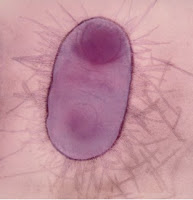Antibiotic Resistant Bacteria | Bacterial Resistance to Antibiotics
Antibiotic Resistant Bacteria - A patient is ill with pneumonia and gets a prescription for penicillin. After 3 days, he feels much better and stops taking his pills. A few days later, his symptoms return. He quickly finds his pills and starts taking them again, but this time they have no effect. What happened? This frightening phenomenon is called antibiotic resistance.
Antibiotic resistance is caused by natural selection. Penicillin kills most of the pneumonia bacteria, but a few penicillin-resistant bacteria survive. These bacteria then multiply, and eventually the patient’s infection comes back only this time, the bacteria are resistant to penicillin.
When penicillin, the first antibiotic, became widely available, it was rightfully lauded as a wonder drug and dramatically cut the number of illnesses and deaths due to bacterial infections. After only a decade of use, however, the first penicillin-resistant bacterial strains appeared. Antibiotic resistance has only increased since then, with more and more bacterial populations becoming resistant to more and more different antibiotics. Diseases once easy to treat—tuberculosis, pneumonia, even common childhood ailments such as ear infections are now often resistant to multiple antibiotics. And in some hospitals, there are infectious bacteria that are resistant to every antibiotic on the market. Because it results from natural selection, antibiotic resistance is inevitable all antibiotic use contributes to resistance.
However, resistance has been greatly accelerated by the overuse of antibiotics. Under pressure from patients, physicians often prescribe antibiotics for illnesses that are not caused by bacteria many commonillnesses, such as colds, flus, and most sore throats, for example, are caused by viruses. These antibiotics select for resistance in the normal (non-disease-causing) bacterial populations in our bodies, making it possible for resistance genes to be transferred to disease causing bacteria that later invade the body. The fact that patients sometimes stop taking their medications too soon only exacerbates the problem by selecting for antibiotic-resistant strains without providing the sustained dose that would actually kill all the bacteria. Antibiotics also see heavy usage in the livestock industry, where animals are sometimes given antibiotics regularly, even when they are healthy, in an attempt to prevent illness. Unfortunately, this practice only increases antibiotic resistance, a fact highlighted in 1983 by the development of antibiotic-resistant Salmonella poisoning in 18 people who ate meat from cows raised on antibiotics.
So, what can be done about antibiotic resistance? First, humans must learn to use antibiotics wisely, taking them only when they are needed that is, for bacterial infections and then taking the entire course of treatment. Physicians and veterinarians can also promote a socially responsible approach to antibiotics by educating patients and agriculturalists on the proper application of these drugs. Finally, since many antibiotics are less effective now because of resistance, scientists must continue to search for new antibiotics that will take the place of those that no longer do the job.
Tags : How do bacteria become resistant to antibiotics?, The Rise of Antibiotic-Resistant Infections, does bacteria become resistant to antibiotics, antibiotic resistant genes, can bacteria become resistant to antibiotics, have bacteria become resistant to antibiotics, Antibiotic Resistance Could Bring 'End of Modern Medicine, Ancient antibiotic-resistant bacteria, Drug resistance, Drug-Resistant Bacteria.
Tidak ada komentar:
Posting Komentar